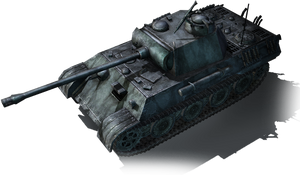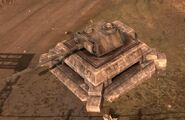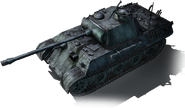 Panther | |
|---|---|
 | |
| Army | Wehrmacht |
| Role | Medium Tank |
| Unit Cost |
|
| Upkeep per Minute |
|
| Produced By | Panzer Command |
| Primary armament | 7.5 cm KwK 42 L/70 |
| Secondary armament | 2x 7.92mm MG42 Light Machine Gun |
| Health |
|
| Armor | Heavy |
| Max. Speed | 5.2 m/s |
If you were looking for the Panzer Elite version of this vehicle, see Panther (Panzer Elite).
The Panther is a heavy vehicle unit buildable by the Wehrmacht in Company of Heroes. It is the most expensive unit to produce in the entire game, and is available in the Panzer Command.
History[]
While vehicles like the Marder III or even the Tiger were made as a direct reaction to the shock of encountering the T-34 and KV-1 vehicles on the Eastern Front, attempting to simply create a vehicle capable of destroying them, the Panther was made with the lessons learned from the Soviet tank projects.
Over the course of a rather long and dramatic development process, the Panther took the T-34's sloped armor and the KV-1's relatively centric turret position, and added on their own touches as mandated by Heinz Guderian's description of the Universal Tank: A main gun capable of defeating any armored vehicle it might face with good range and penetration, and a smattering of Machine Guns for dealing with the Infantry. Combat experience also gave rise to a more front-centric armor layout, something also imitated in later war German vehicles like the Hetzer or King Tiger, as the Wehrmacht had found in practice that most vehicle combat happened longer range, and that a tank being flanked at close range was likely dead even if the armor there was substantial.
Despite all of these hypothetical upsides, however, it still took around a year from the Panther's 1943 debut for the vehicle to begin to have the expected impact from the design. A rush to get vehicles on the field meant that many examples of the first version (inexplicably "Ausf. D", with the A version coming later) were prone to frequent breakdown, something which has entered military pop culture as a fact of the design as a whole, in part because of a misunderstanding of Soviet reports on later versions of the vehicle (who were abandoning captured Panthers due to a lack of spare parts for them in Soviet supply).
By 1944, however, these issues had been fixed, and combat had begun to prove the value of the vehicle, which was considerably superior to the existing Panzers III and IV in almost every conceivable way aside from a negligibly worse High-Explosive shell. As a result, the Panther was planned to replace both vehicles in full by 1945, and even in light of Allied bombing raids on production centers, did end up exceeding Panzer III production over its short lifespan. However, even with a surprisingly significant number of vehicles produced, with 38% of Panzers in the Battle of France being of the design and a plurality of them in the Low Countries (most notably the Battle of the Bulge), they never fully replaced their predecessors.
Despite this, in the Normandy campaign, the Panther's performance was a shock to the Western armies nearly as much as the T-34 and KV-1 had been to the Germans on the East. Not only were they on the field in considerably higher numbers than initially predicted, but the Sherman and M10 main guns could not penetrate their front armor at all, requiring air support to deal with the vehicles on most occasions. Conversely, the Panther was capable of penetrating their own armor at any effective combat range. The British Firefly was able to match the vehicle well, but were initially fielded in far too small of numbers given the underestimation of the vehicle. Common and tough to deal with, the Panther became a nuisance unmatched even by the Tiger and King Tiger in this theater, and the M36 Tank Destroyer and M26 Pershing tank would be rushed into production to counter them, ultimately successfully.
The version of the Panther in Company of Heroes is the Ausf. ("Ausführung", or Version) A, which, as mentioned above, despite the name, was the second major production model.
Overview[]
With a hefty price tag, long production time, and a spot at the back of the Panzer Command, already the last tiered building constructed in most games, the Panther is likely to be one of the last things to enter the battlefield outside of a call-in. In fact, most Victory Point Control games, outside very competitive ones with long timers, will have ended by the time the first one is viable to be produced. If a Wehrmacht commander is able to field one, however, especially with Veterancy, it is unlikely the game will last terribly much longer to follow.
The Panther is a very hard nut for Allied armies to crack. Only two vehicles in the entire game, the Pershing and the Firefly, can reasonably win the 1v1 against it, and even the Firefly needs a Command Tank and the first shot or a continually maintained range advantage to do so. Even the 57mm Anti-Tank Gun is fairly ineffective against it, with several consecutive shots (ideally using Armor-Piercing Rounds) needed to even put a dent in the Panther, let alone get rid of it. Infantry-based Anti-Tank weapons like the Sappers' PIATs work for a while, but the combination of the veterancy upgrades eventually make these measures both less useful and more dangerous.
This makes the operation of the vehicle fairly simple: Within reason, the Panther can perform any task assigned to it. The Panther is good in virtually every possible scenario, save perhaps attempting to assault a 17 Pounder emplacement head on. While it will not out-perform a Panzer IV against Infantry, given the Panther's considerably better armor and HP, it will do sufficiently enough. Against vehicles, specialists or large numbers are required to take the vehicle out, and even this will rarely happen quickly enough that a Panther cannot retreat first. As a result, the vehicle can operate independently or in combined arms operations to equally effective degrees.
Adding to the Panther's strengths is its tactical mobility. While not the fastest vehicle in the Wehrmacht's arsenal, it is the fastest tank, with fairly good acceleration and turn speed to match (the Geschutzwagen is technically faster, but so much worse in the other respects that in practice it is typically slower). It also has the "Heavy Crush" effect, allowing it to crush Tank Traps, Hedgerows, and most other destructable objects on the map. This can make the Panther a deceptively mobile vehicle- its size makes it appear to be a lumbering behemoth, but actually it's just as fast as a Sherman, with the additional free ability to go through obstacles, making it a surprisingly good flank attacker.
The Panther's HP pool is also rather large, with only the game's Heavy Tanks having a larger pool. This means that an offensive can often continue even when the vehicle is damaged. This has a downside, however: In the worst-case scenario, Pioneers may require nearly two and a half minutes to fully repair a particularly mangled Panther. As such, it is generally advisable to keep at least one squad nearby at all times, and equally so to take calculated risks with the vehicle. Sending a partially damaged Panther into an Anti-Tank Gun's field of fire is a poor plan, but sending it to a one-on-one encounter with a Cromwell, for example, is not a bad idea.
Overall, the Panther should be produced as early as possible, with the Panzer IV used as a buffer to allow time for its production, and used as aggressively as the battle will allow. It can turn a losing game and can be the kiss of death in a winning game, so long as it is never allowed to be completely overwhelmed by numbers or flanked. So long as its massive cost and construction time is kept in mind,
Weapons[]
7.5cm KwK 42 L/70[]
The Panther's main weapon is the 7.5 cm Kampfwagenkanone 42 L/70, a lengthened and electrically enhanced version of the Panzer IV and StuG IV's main guns. It is primarily designed as a weapon for fighting other tanks at an extreme range. For the most part, Company of Heroes depicts this fairly accurately.
The gun fires shells that deal 137.5 damage a shot, though this is reduced to 20 on the rare occasion that the shell fails to penetrate armor. The only Allied unit that does more damage on hit than this is the 17 Pounder in its fixed emplacement, or potentially any captured Flak 36 batteries. The KwK 42 takes 7 seconds to reload, and has a negligible aim time, though the somewhat slow turret traversal of the Panther means that sometimes it will be longer.
Like most of the Wehrmacht's largest guns, the Panther's main gun is incredibly accurate and loses little penetration power over distance. It has a long range of up to 47.5 meters, well longer than its sight line, and in up to 35m of that, the gun has perfect accuracy against most units and nearly comprehensive penetration capabilities, with only the Pershing being able to resist the incoming fire between 40 and 45% of the time, depending on range. Past the 35m mark, however, the Panther is reduced to a (still fairly impressive) 83% in both respects, though in practice this matters little given that only one Allied vehicle gun (the Firefly's) can actually match its range.
The shells have almost no Area of Effect whatsoever, nor do they have any suppressive power. However, they are surprisingly accurate against static Infantry, with 60% accuracy against static targets, or 75% and even 90% against units in the open and negative cover respectively, though this is decreased dramatically if the Infantry are moving at all. Still, this means that if Infantry are attempting to stand their ground, the Panther can act as a high-caliber sniper, able to pick off VIPs at a long range, as it still retains its high accuracy against Elite infantry, Snipers, and other high-value targets.
Still, with a modestly long reload time and superb anti-vehicle capabilities, the KwK is best suited for fighting vehicles, and allowing its compliment of Machine Guns or friendly units to handle the Infantry whenever possible, though it's certainly able to deal with Infantry if no better target exists.
7.92 mm Maschinengewehr 34[]
The Panther's secondary weapon is the direct predecessor of the feared Maschinengewehr 42, the Maschinengewehr 34. By default, two machine guns are present, one in the hull (which has a very narrow of cone of fire in front of the vehicle) and one in the coaxial position in the turret. The MG will fire 15-25 rounds dealing 3 damage per shot to unarmored targets up to 25m away before reloading for 3-4 seconds. Like many other machine guns, most infantry will take reduced damage by default. Unlike most other machine guns, the Wehrmacht's Hull and Turret MGs have reduced accuracy when enemy Infantry is too close to the vehicle, meaning the best possible result (roughly 10% accuracy before cover reductions) is in the middle of its range.
With such poor damage and accuracy, the MG34s on the Panther are only even noticeable when working in tandem with each other, and even then are not the most effective and reliable weapons. Worse, they lack suppression almost entirely, having comparable amounts to most SMGs. As a result, they are a good supplement to existing anti-infantry weaponry, and will help tilt battles in favor of Axis infantry if the hull is properly positioned, but are not sufficient at the job by themselves.
7.92 mm Maschinengewehr 42[]
The Panther's MG42 is statistically very similar to those used on top of the turrets or hulls of other Wehrmacht vehicles. Manned only once the vehicle reaches Veterancy 2, It fires bullets that do 5 damage against unarmored targets (though this number is reduced by most Infantry armor in most situations), in bursts of 15 to 30, followed by a 6 to 6.5 second reload. Its range of 35m is just shy of the main gun's range, and has a full degree of rotation independent of the turret, with a very negligible turn speed.
For a rapid fire weapon, the Panther's MG42 is actually rather accurate, with a base 45% accuracy outside of its absolute maximum range. Most British Infantry and a few American units, most notably Airborne, do have innate reductions against this, however. As with its statistically near-identical contemporaries, the Panther's MG42 is almost useless against infantry in any real degree of cover, with fairly substantial maluses to both accuracy and damage to units therein. However, units in negative cover, water, or even simply the open are more directly effected, and likely to be suppressed.
Though the main gun is slightly worse at dealing with Infantry than the Panzer IV's, the Panther's compliment of MGs are statistically identical, outside the rather trivial detail of the gunner being harder to kill owing to the Panther's higher HP pool. In practice, the Panther often has better things to do than to slaughter Infantry in the open, but as a deterrence weapon, it does the job quite well. Its full rotation allows it to deal with Infantry even on the side of the vehicle, which can be helpful in ambush situations, and the combination of the three MGs make frontal assaults rather nightmarish prospects for the likes of Rangers or even the rare PIAT Commandos.
Veterancy[]
The Panther receives veterancy through researching tank veterancy upgrades, available at the Kampfkraft Center. These following bonuses are cumulative, and apply to all existing and newly-created units.
No Veterancy:
| |
Level 1 Veterancy:
| |
Level 2 Veterancy:
| |
Level 3 Veterancy:
|
Surprisingly, given its position at the very end of the Wehrmacht's non-doctrinal roster, the Panther will sometimes be in games where its higher veterancy levels are only of dubious value, especially against a U.S. Army commander using Armor Company. However, as Infantry-based Anti-Tank Weapons are among the best ways to actually deal with Panthers, Veterancy 3 is highly recommended in games where it will be commonplace.
Tips[]
- Panthers rarely actually need help dealing with Vehicles. As a result, Knight's Cross Holders and MP40-armed Volksgrenadiers pair quite well with the vehicle, keeping Infantry at bay while providing the occasional flanking Panzerfaust support when needed.
- Even the few vehicles that outmatch the Panther will not be able to do so if it's able to get some rear armor shots in first. Use the vehicle's speed and heavy crush ability to flank larger Allied vehicles and dug-in positions.
- The Blitzkrieg ability showing a picture of the Panther is no coincidence. The ability speeds up both the main gun and the machine guns quite significantly, and the main gun's already near-pinpoint accuracy makes the loss negligible.
- Though the Panther's turret speed is slow, you can help move it faster by rotating the hull in conjunction with the turret, helping the vehicle quickly respond to flanking maneuvers.
Weaknesses[]
The Panther is a vehicle with very few direct weaknesses. Outside of getting a Pershing or well-supported Firefly out at an ideal time, or simply drowning the vehicle in raw numbers, there are, by design, not particularly many reliable methods of dealing with the vehicle, and most come at a rather high cost.
The best way to actually destroy a Panther is by luring it into the field of fire of a 17 Pounder, which will, at minimum, do a significant amount of damage that will require a very long repair. Infantry-based Anti-Tank weapons are also very effective if a Panther has no ranks in veterancy, with units like Airborne being able to flank the vehicle, ignore its rather sub-par MG34 compliment, and whittle it down. Numbers are also good- while a Panther will often win even a two-to-one engagement with Shermans, a swarm of vehicles, especially supported by AT Guns or AT Infantry, will finish a Panther off just fine, though at considerably higher cost and build time.
Both Off- and On-Map Artillery do respectable damage to Panthers, even if it will be unlikely to kill them, but in terms of ability usage, a single Sticky Bomb to slow the vehicle followed by a bombing run will typically be enough to destroy a Panther, if not cripple it heavily, though for a king's ransom of munitions. Speaking of crippling, its high HP pool can be a curse sometimes: Though Mines and Sticky Bombs will rarely destroy a Panther, its high HP pool leads to very slow repair speeds, meaning that the vehicle often spends as much time being repaired as it does fighting, much like its earlier real life models.
The best counter to the Panther, however, is to simply not let it exist in the first place. Aggressively pushing back against the Wehrmacht once a Tank Depot or Armor Command Truck is constructed, especially targeting fuel points during this time, will force the Axis players to rely on cheaper vehicles for, if nothing else, the time being, which will match up far worse with the Allied armor roster. If correctly dealt with, this can ensure that the Panther is never deployed to be a problem to begin with.
Panther Variants[]
The Jagdpanther is built using the Panther's chassis, with a large 88mm gun similar to the King Tiger's in place of the standard main gun, as well as some additional armor (particularly on the front).
There is also a stationary variant of the Panther, the Pantherturm, unsurprisingly meaning "Panther Turret" in German. Essentially, it is a bunker with, instead of a roof, has the turret of a Panther. It only appears operational in the campaign and the Verrieres Ridge map, and can be repaired after being destroyed to be controlled by the player.
Gallery[]
Quotes[]
When damaged and under fire:
Trivia[]
- The MG42 on top of the turret has no turning animation, though it is still able to track targets all around the tank. This frequently results in the weapon firing at odd angles, including through the gun and gunner.
| Wehrmacht Arsenal | |||||||
|---|---|---|---|---|---|---|---|
| Base Structures | |||||||
| Infantry Squads | |||||||
| Support Infantry | |||||||
| Light Vehicles | |||||||
| Medium Vehicles | |||||||
| Heavy Vehicles | |||||||
| Defensive Structures | |||||||
| Other Structures | |||||||
| Doctrines | |||||||
| Doctrine-specific Units |
| ||||||
| Doctrine-specific Structures |
| ||||||








